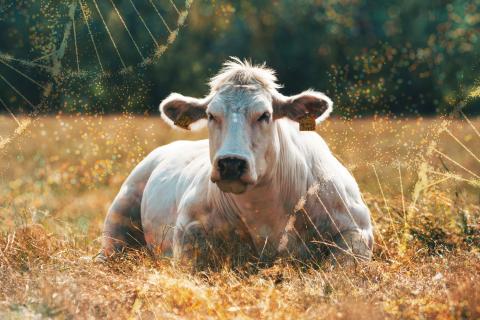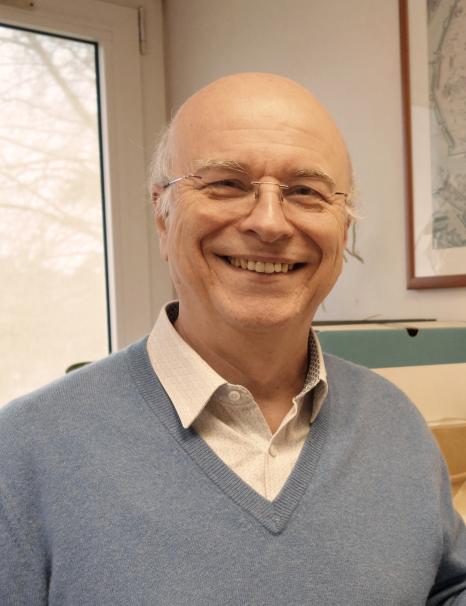
Didier Boichard: revolutionising cattle selection using genetics
Didier Boichard is an INRAE director of research in the Bovine Genetics and Genomics team of the Animal Genetics and Integrative Biology Laboratory (GABI - Univ. Paris-Saclay/French National Research Institute for Agriculture, Food and Environment, INRAE/AgroParisTech). His research into the characterisation and genomic selection of cattle has revolutionised the world of agriculture.
Originally from the Franche-Comté region, Didier Boichard was fascinated by cattle from an early age. After graduating as an agricultural engineer from AgroParisTech (formerly the National Agronomic Institute Paris-Grignon) in 1982, he completed his national service in Tunisia. On his return, after a 2nd year Master’s degree in quantitative genetics at the Pierre and Marie Curie University (now Sorbonne University), he undertook a thesis on dairy cow fertility as a scientific assistant at the National Institute for Agricultural Research (INRA), before leaving for a post-doctorate in Canada in 1990. In 1987, he joined INRAE as a research fellow, becoming director of research in 1996.
Genomic selection: a revolution for breeding
In the early 90s, Didier Boichard foresaw the potential of molecular genetics for cattle selection on traits of interest. "As cows only have one calf a year, selection is based mainly on bulls. But these do not express traits of interest, such as milk production. In the past, their potential was assessed by progeny testing where, cows were inseminated with bull semen, then the performance of the resulting daughters was measured. If they were satisfactory, the bull was distributed for breeding."
This practice lasted 50 years, until the advent of genomic selection, which enables animals to be selected using genotyping before they are a month old. Genotyping involves analysing several thousand markers across the entire genome. The effect of each marker is estimated using a large "reference" population of genotyped animals with performance data. A pioneer in this field, Didier Boichard has been advocating the use of genomic selection in dairy cattle since 2009.
Synergy between research and selection
Didier Boichard's work is based on a cattle database created in 1970. "This database, one of the most extensive worldwide, contains a multitude of characteristics such as pedigree, reproduction, production, health, appearance and carcass value. Each cow has its own passport containing all the characteristics of that cow." Added to over time, this database is a mine of information that the researcher exploits both for research purposes and to assess animals for selection. "The animals' genetic value is estimated using complex mathematical methods. We then provide this information to breeders, who use it to select breeding stock. In return, we can access to this database for our research. So, there is a strong synergy between breeding and research."
The rise of genomics
From 2002 to 2009, Didier Boichard headed INRA's animal genetics department, which employed 500 people across France. It promoted the development of genomics and transcriptomics platforms in Jouy-en-Josas and Toulouse and drove research into Single Nucleotide Polymorphism (SNP) markers. "Their abundance and the availability of high-throughput genotyping tools make these markers a preferred choice for genomic selection." The researcher also developed the Labogena Economic Interest Grouping (EIG) to provide the genotyping capacity needed for selection and research. At the same time, with his team, the Institut de l'élevage (French Lifestock-Breeders' Institute, Idele) and the Eliance federation, he set up the eBIS Joint Technology Unit, a public-private structure accredited by the French Ministry of Agriculture and employing 40 people from the GABI laboratory.
Sustainable genomic selection
As genomic selection is a powerful tool, Didier Boichard proposes population management methods to obtain the best compromise between selection and maintaining genetic variability. Currently, around 400,000 calves are genotyped every year, a figure that is constantly rising. "Previously, we could only select a limited number of traits, which often led to a decline in those not selected." Today, breeders select their animals in a more balanced way, based on a multitude of traits: milk production, milk quality, health, morphology, longevity, docility, and soon even methane emissions and thermotolerance.
More recently, Didier Boichard's team has begun exploring epigenetics, "where mechanisms modify gene expression without modifying the genes themselves". His team contributed to the first epigenotyping chip in cattle, a tool that can be used on a large scale. "Just as we developed SNP chips to analyse the genome, we will now analyse the level of DNA methylation and study its impact on the future performance of animals, and even their progeny."
Detecting genetic anomalies
In the early 2000s, Didier Boichard began working on the detection of genetic anomalies in cattle. "They've always existed, but were difficult to recognise. Now, using large-scale genotyping, we can accurately identify the mutation causing the anomaly." He contributed to the creation of the National Observatory of Bovine Anomalies (ONAB) and then coordinated the ANR BONAVO project. His team developed screening tests for breeders, in particular the "SNP chip used in genomic selection, which has become a simple, rapid diagnostic tool".
While simple anomalies are now easy to characterise, others remain more difficult to identify, as they are not very visible at phenotypic level. Didier Boichard and his team are therefore developing different approaches, based on genotyping and phenotyping data, to identify mutations responsible for embryonic mortality or shortened lifespan.
Towards large-scale sequencing
In order to identify mutations responsible for monogenic or complex traits, access to a large number of complete genome sequences is required. Consequently, Didier Boichard co-founded the international 1000 Bull Genomes Consortium Project in 2013. "Each member contributes a minimum number of sequences and has access to those of others. After ten years, the consortium has shared almost 6,000 sequences." Work is continuing on a similar strategy applied to long-read sequencing to characterise the bovine pangenome.
Predicting methane emissions
Didier Boichard's team has recently developed an innovative method capable of predicting methane production in cows using infrared spectra of milk. This approach leverages millions of existing data points and bypasses the limitations of costly and complex direct measurements. Indeed, fermentations in the cow's stomach, which are responsible for methane production, influence milk composition and can be detected through spectral analysis. Other strategies are also being explored to reduce methane emissions, such as encouraging first calving at two years of age to limit the number of "non-productive" cows, increasing their longevity to reduce replacement needs, or reducing cow weight.
A member of the French veterinary academy, the Académie vétérinaire de France, Didier Boichard has been the recipient of several awards. These include the 2015 Gold Medal from the French Academy of Agriculture (Académie d’agriculture de France), the 2016 Impact award from INRAE and the 2024 Dujarric de la Rivière Award from the French Academy of Sciences (Académie des Sciences). Just some of the spotlights that highlight research that is shaping a strategic sector of society.

